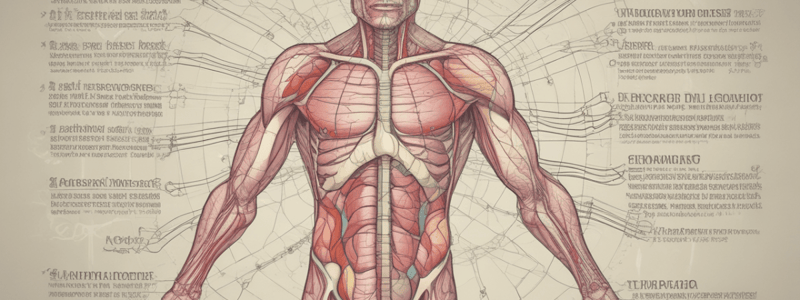Podcast
Questions and Answers
What is the main function of the endocrine system?
What is the main function of the endocrine system?
- To regulate body temperature
- To secrete hormones directly to the blood (correct)
- To transmit nerve impulses
- To produce digestive enzymes
Which of the following glands is part of the endocrine system?
Which of the following glands is part of the endocrine system?
- Kidneys
- Suprarenal gland (correct)
- Pancreas
- Liver
What is the main difference between chromophobes and chromophils?
What is the main difference between chromophobes and chromophils?
- Chromophobes have granular cytoplasm, chromophils don't
- Chromophobes don't take histological stain, chromophils do (correct)
- Chromophobes take histological stain, chromophils don't
- Chromophobes are smaller, chromophils are larger
Which cells in the pars distalis produce growth hormone?
Which cells in the pars distalis produce growth hormone?
What is the function of the posterior lobe of the pituitary gland?
What is the function of the posterior lobe of the pituitary gland?
What is the characteristic of the cells in the pars nervosa?
What is the characteristic of the cells in the pars nervosa?
What is the name of the hormone produced by lactotrophs?
What is the name of the hormone produced by lactotrophs?
What is the characteristic of the cells in the pars intermedia?
What is the characteristic of the cells in the pars intermedia?
What is the function of the cells in the zona glomerulosa of the adrenal cortex?
What is the function of the cells in the zona glomerulosa of the adrenal cortex?
What type of cells are found in the pituitary gland?
What type of cells are found in the pituitary gland?
What is the function of the principal cells in the thyroid gland?
What is the function of the principal cells in the thyroid gland?
What is the location of the Herring bodies in the pituitary gland?
What is the location of the Herring bodies in the pituitary gland?
What is the function of the C cells in the thyroid gland?
What is the function of the C cells in the thyroid gland?
What is the characteristic of the cells in the zona fasciculata of the adrenal cortex?
What is the characteristic of the cells in the zona fasciculata of the adrenal cortex?
What is the location of the pituicytes in the pituitary gland?
What is the location of the pituicytes in the pituitary gland?
What is the characteristic of the zona reticularis of the adrenal cortex?
What is the characteristic of the zona reticularis of the adrenal cortex?
Study Notes
The Endocrine System
- The endocrine system secretes hormones directly into the blood, including the pituitary gland, thyroid gland, and suprarenal gland.
The Pituitary Gland
- The pituitary gland has anterior and posterior lobes.
- The anterior lobe consists of:
- Pars distalis
- Pars intermedia
- Pars tuberalis
- The posterior lobe (neurohypophysis) consists of:
- Pars nervosa
- Pars distalis:
- Surrounded by a thin CT capsule
- Consists of irregular cords of cells with numerous fenestrated capillaries
- Cells of Pars distalis:
- Chromophobes (52%): smaller, non-granular cytoplasm, don't take histological stain
- Chromophils (48%): larger, granular cytoplasm, take histological stain
- Chromophils:
- Acidophil cells (37%): moderate in size, have acidophilic granules, secrete somatotrophs (Growth Hormone, GH)
- Basophil cells (11%): larger in size, have basophilic granules, secrete thyrotrophs (Thyroid Stimulating Hormone, TSH)
- Lactotrophs: secrete prolactin
- Gonadotrophs: secrete Follicle Stimulating Hormone (FSH) and Luteinizing Hormone (LH)
- Corticotrophs: secrete Adrenocorticotrophic Hormone (ACTH)
- Pars intermedia:
- Separated from Pars distalis by a thin, incomplete cleft
- Cells arranged in follicles or cords with blood vessels in between
- Pars nervosa:
- Lightly stained due to few cells and mainly nerve fibers
- Nerve fibers carry neurosecretory material from the hypothalamic nuclei
- Neurosecretions (vasopressin and oxytocin) are stored in Herring bodies
- Few cells, "pituicytes", are neuroglial cells
- Rich blood capillaries
The Thyroid Gland
- The thyroid gland is surrounded by a CT capsule, which sends septa to divide the gland into indistinct lobules
- The parenchyma is formed of follicles, which are filled with acidophilic colloid
- Lining epithelium varies from flat to columnar
- Two types of cells are present:
- Follicular cells (principal cells): main type of cells, secrete thyroid hormones (T3 & T4), cuboidal, columnar, or squamous
- Parafollicular cells (C cells): secrete thyrocalcitonin hormone, larger in size, don't reach the follicular cavity
- Blood capillaries are found between the follicles
The Suprarenal Gland
- Each gland has an outer cortex and an inner medulla
- The adrenal cortex:
- Zona glomerulosa: a narrow zone under the capsule, formed of columnar acidophilic cells, secretes mineralocorticoids (aldosterone)
- Zona fasciculata: the middle zone, formed of large polyhedral cells with acidophilic vacuolated cytoplasm, secretes glucocorticoid
- Zona reticularis: the inner zone, formed of small polyhedral cells with less vacuolated cytoplasm, secretes sex hormones and some glucocorticoids
Studying That Suits You
Use AI to generate personalized quizzes and flashcards to suit your learning preferences.
Related Documents
Description
Learn about the endocrine system, its functions, and the structure of the pituitary gland, including its anterior and posterior lobes.





